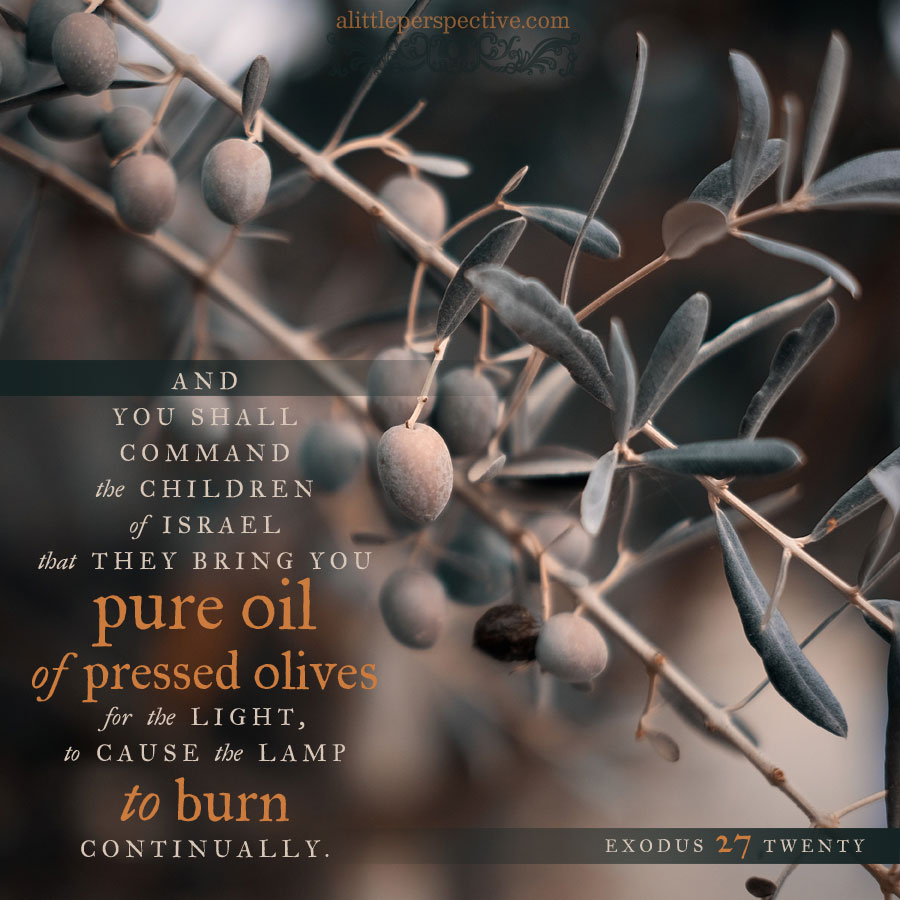Read Exodus 25 through 27 at Bible Gateway.
The Hebrew paragraph divisions
Exo 25:1-9 {s} The offering commanded to build the Tabernacle
Exo 25:10-22 {p} The pattern for the ark of the covenant
Exo 25:23-30 {p} The pattern for the table of showbread
Exo 25:31-40 {s} The pattern for the golden lampstand
Exo 26:1-14 {p} The pattern for the curtains and coverings of the Tabernacle
Exo 26:15-30 {s} The pattern for the frame of the Tabernacle
Exo 26:31-37 {s} The pattern for the veil + placement of ark, table, lampstand + screen
Exo 27:1-8 {s} The pattern for the altar
Exo 27:9-19 {s} The pattern for the outer court
Exo 27:20-21 {s} Oil for the lampstand + continual tending of the lampstand’s light
I have been dwelling on the tabernacle not as an end in and of itself, but as a natural picture teaching a spiritual truth. Natural pictures are a teaching tool of Scripture, and one Yeshua made heavy use of in His first advent. Parables are, after all, a natural picture – a story of something we are well familiar with in our daily lives – which teach spiritual truths. You can read more about the spiritual truths taught by the tabernacle and the priesthood and the offerings, in Hebrews, especially Heb 8.
From these three chapters, we learned that the tabernacle consisted in three parts. The innermost part, the Holy of Holies, was veiled off from the rest of the structure, and only the high priest entered it once annually, on the Day of Atonement. The only article of furniture within it was the ark of the covenant. Overshadowed by the wings of the golden cherubim, the ark represented the throne of God on the earth. The ark was a hollow box, in fact, we learned that its root word, “to gather,” was the same root for a cattle pen or ox stall! Within the hollow box, were the two tablets of the Ten Commandments, the summary of the Torah. And covering over the box, was the mercy seat of God’s authority. It is from His throne that the Commandments came, as well as the mercy, covering over our repented transgressions of the Commandments.
The heart of man, the physical heart of man’s body, is also a hollow box. This hollow organ is meant to hold something within it; that is, the life-giving blood, which it then distributes to all corners of the body. In the same way, the spiritual heart or inner man is hollow and is meant to hold something within it that it distributes to all corners of the person. YHVH admonishes us to be sure that His words are what fills our hearts. They are life-giving, and the heart will distribute that life from the inner man to all corners of the person.
The natural picture of the ark is an object lesson, representing the heart of man, within which is kept – guarded – the Torah, the Word of God, covered over by His mercy, and where His presence dwells. The Holy of Holies is an object lesson representing the spirit of man.
The second part of the tabernacle is the Holy Place. The Holy Place surrounds the Holy of Holies, and within it was the lampstand, the table of showbread, and the altar of incense.
The bread of God resided on the table, and was renewed daily. Yeshua said, Man shall not live by bread alone, but by every word which proceeds from the mouth of God (Mat 4:4). Moreover, He is the Word made flesh (Joh 1:1, 14) which is the bread of life (Joh 6:35).
The light from the lampstand, which was to be tended morning and evening so its light did not go out, also represents the word of God:
Your word is a lamp unto my feet, and a light unto my path. Psa 119:105
The altar of incense represents our prayer ascending before the Father. It also was to be lit daily.
Now if the Holy of Holies represents the spirit of man, the Holy Place represents the soul of man: the mind, will, and emotions. The word of God to man, represented by the bread, and the light, was to be kept fresh, daily lit within the mind. The bread of life feeds our soul, and the light of His word illuminates our darkness. Our prayer, the word of man to God, was also daily refreshed.
The third part of the tabernacle was the outer court, surrounding the Holy Place and the Holy of Holies. The laver for washing, and the bronze altar of sacrifice, was located in the outer court. It represents the physical body of man. It is the body, the outer court, that must be daily washed. It is the physical body which touches the fallen world. It is, moreover, the deeds of the body that must be daily confessed, and repented, and the sin sacrifice of the blood of Messiah Yeshua applied.
For further study
Exo 25:31-26:14, the natural picture of the tabernacle curtains

















Leave a Reply